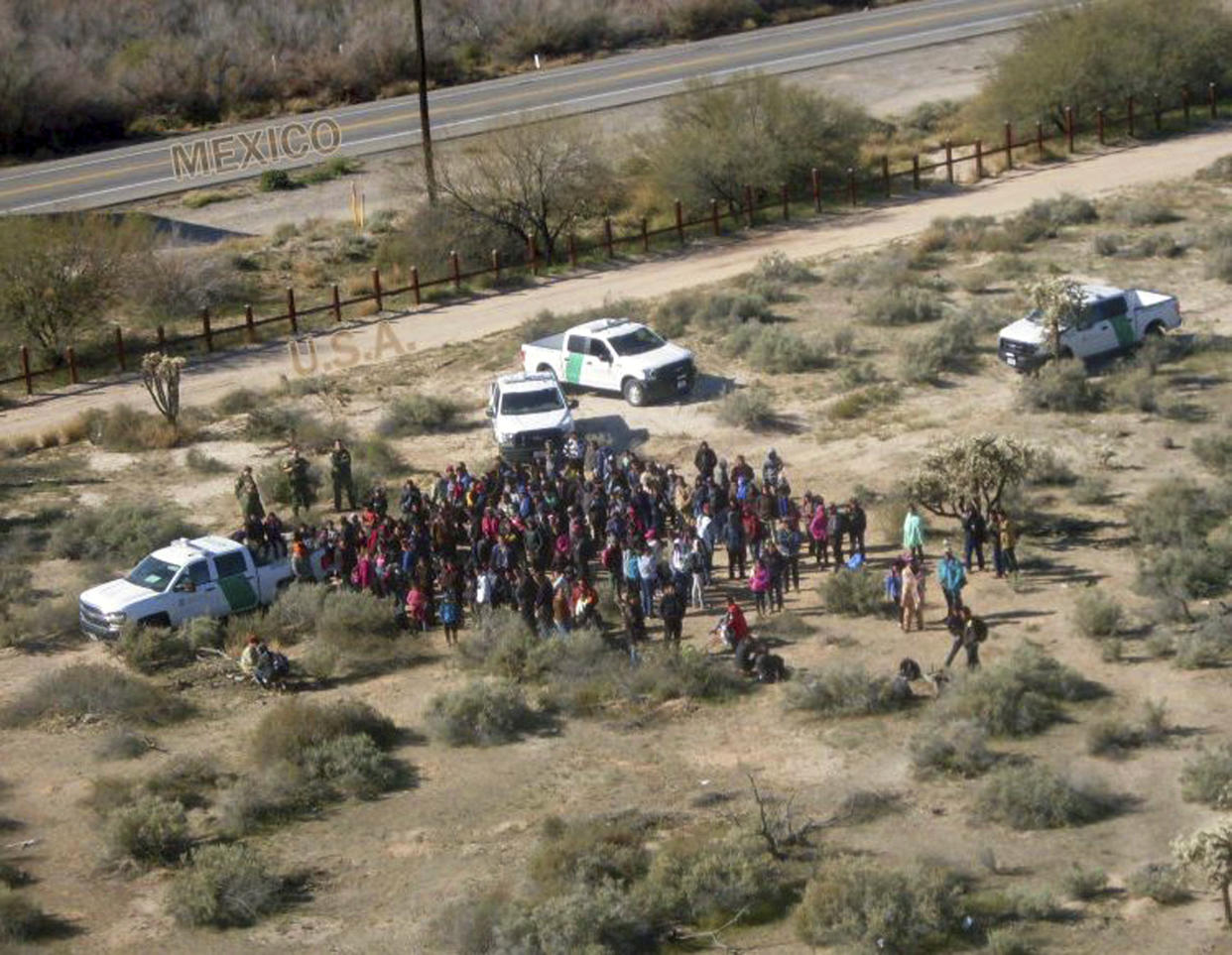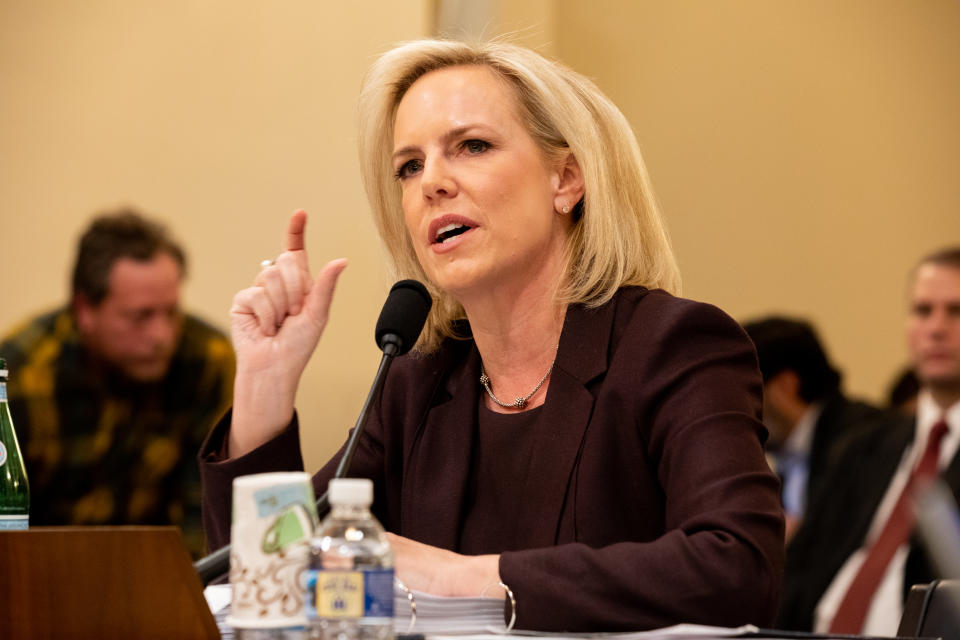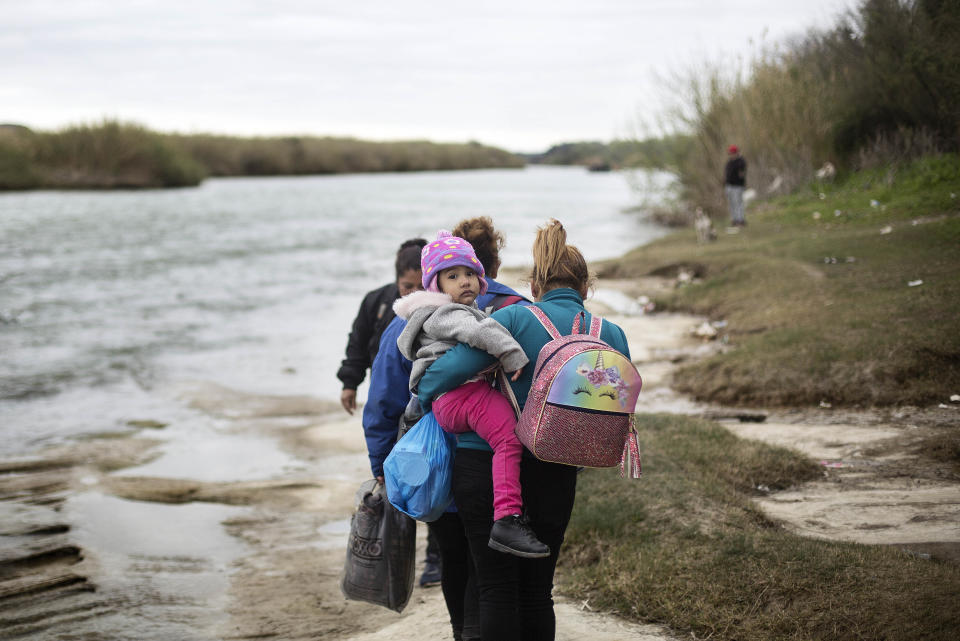Trump officials cite 'crisis' on border as arrests spike, but doubts surface on numbers

About three weeks after President Trump first declared a national emergency to unlock funds for his border wall, prompting a slew of lawsuits and a vote in Congress to block it, U.S. Customs and Border Protection released new border apprehension data that seemed, on its face, to be exactly what he needed. According to CBP, the number of people arrested for illegally crossing the border rose from 47,986 in January to 66,450 in February.
Though still far below historic highs reported during the 1990s and early 2000s, the February stats were in line with a trend that has been in place since last fall, bringing the average monthly arrest rate over the preceding five months to its highest level in a decade. Most of the arrests were of family members and unaccompanied minors.
Administration officials immediately seized on this data.
“This is clearly both a border security and humanitarian crisis,” U.S. Customs and Border Protection Commissioner Kevin McAleenan said at a press conference announcing the newest numbers Tuesday.
“Illegal immigration is spiraling out of control and threatening public safety and national security,” Homeland Security Secretary Kirstjen Nielsen told members of the House Homeland Security Committee at a hearing Wednesday, citing the latest CBP data to defend the president’s use of emergency powers. The House has voted to disapprove Trump’s declaration and the measure appears to have enough Republican support to pass in the Senate, although probably not by a margin sufficient to overturn a likely veto.
“This is not a manufactured crisis,” Nielsen said. “This is truly an emergency.”

Making it seem like an even bigger emergency, the administration reported a total of 76,103 “enforcement actions” at the southern border, a figure that includes 9,653 “inadmissibles” — people who attempted to enter at a legal port of entry but who for some reason, such as an expired passport or invalid visa, were denied entry. Many news organizations reported the higher total.
Both the numbers themselves and their use to justify Trump’s declaration have elicited skepticism from outside experts, who question whether the increase in illegal crossings was an unintended consequence of the administration’s policies — or even an intended one.
“They’re playing a very central role in shaping the flows to and across the border that they’re not acknowledging,” said Omar Jadwat, director of the ACLU’s Immigrants’ Rights Project. He believes the Trump administration has “taken a number of actions that are clearly going to have the effect of pushing people to cross the border between ports of entry.”
Jadwat is one of the lead attorneys behind some of the ACLU’s ongoing legal challenges to the Trump administration’s immigration policies, including the emergency declaration.
The organization won a court order to delay implementing some of Trump’s policies, such as the ban on processing asylum applications from people who cross the border illegally. But the administration has continued to pursue other policies and procedures that effectively restrict access to the asylum process. In coordination with Mexican officials they are enforcing strict daily limits on the number of asylum applications accepted at certain ports of entry, requiring migrants to wait several days or weeks in Mexican border towns before they can even present themselves to U.S. officials.
And then, under a new policy put in place this year, most asylum seekers are being made to wait in Mexico even after submitting their applications, for months or years until their cases are decided — a major departure from previous practice, under which immigrants could be paroled into the U.S. until they come up for a hearing. The policy, which the administration calls Migrant Protection Protocols, is the subject of another federal lawsuit by the ACLU and other groups.
Jadwat believes that the administration has helped fuel rise in illegal crossings by making it harder to request asylum at ports of entry — and he thinks it might have been done knowingly, to force desperate migrants to risk crossing the border illegally in numbers that will justify the “supposed emergency.”

Aaron Reichlin-Melnick, a policy analyst for the American Immigration Council, agreed that the Trump administration’s efforts to keep asylum seekers waiting in Mexico have likely had an impact on the recent apprehension numbers.
Reichlin-Melnick cited a survey of more than 500 asylum seekers at ICE’s family detention facility in Dilley, Texas. More than 90 percent of them said they did not feel safe in Mexico.
Forty-six percent of respondents said that they or their child experienced “at least one type of harm” while in Mexico, and 38 percent reported being mistreated by Mexican police.
“The data show people simply don’t feel safe at the border, and when they don’t feel safe and are told it’s going to be an unknown period of time until you can enter [the U.S.], people often make the difficult decision to cross the border illegally rather than risk their lives waiting in Mexico,” said Reichlin-Melnick.
“A lot of people are likely unable to wait in unsafe conditions in Mexico and are making the decision to cross between ports of entry instead,” he said. “No person crosses the Rio Grande for fun,” he added. “No one takes their 7-year-old across the river if they have another choice.”
Asked to address some of the questions raised by the latest apprehension numbers, a CBP spokesperson referred Yahoo News to a variety of materials from the agency’s website as well as a transcript of Tuesday’s press conference, which focused largely on the changing demographics of today’s migrant population from predominantly single men to mostly families and unaccompanied minors, and the legal and logistical challenges border agencies face in accommodating these more vulnerable groups.
Immigrant rights advocates and vocal opponents of the administration’s policies on asylum aren’t the only ones skeptical of Trump’s attempt to spin the latest apprehension figures.
Alan Bersin, an Obama official who was known as the “border czar” and who generally shares the Trump administration’s view that the flow of Central American families and children seeking entry is largely a product of “loopholes” in our “broken asylum system,” also dismissed the idea that the increase in arrests was evidence of a crisis or what Trump has characterized as an “invasion.”
“To the contrary,” said Bersin, “it really is an example of executive incompetence.”
Bersin, who served in several capacities in the Obama administration, had been optimistic about Trump’s plan to make asylum seekers wait in Mexico, telling Yahoo News last month that the policy was “the first thing that the Trump administration has done that has a reasonable chance of deterring people from starting out in Central America.”
However, just over a month after the policy was first implemented at the San Ysidro Port of Entry between Tijuana and San Diego, the Mexican government has reported that only about 150 asylum seekers have been sent back to await adjudication of their claims. Bersin views this, together with the rise in illegal border crossings, as signs of “failure” and “incompetence” by the administration.
“This shows that every policy they’ve tried to create a deterrent has been an absolute debacle,” he said. “If I were cynical I might suggest this incompetence is intended to let enough people in so that it backs up this theory of a national emergency.”
Read more from Yahoo News:
Women divided by race over key issues, but with areas of overlap
Maverick Republican William Weld looks to run against Trump’s ‘malignant narcissism’
The Army’s killer drones: How a secretive special ops unit decimated ISIS
The Soviets wanted to infiltrate the Reagan camp. So the CIA recruited a businessman to bait them.
PHOTOS: Desert takes starring role in photographer’s breathtaking Milky Way shots



